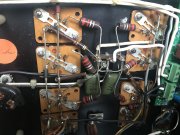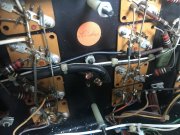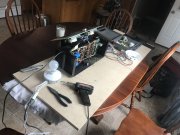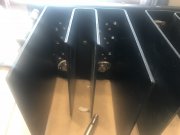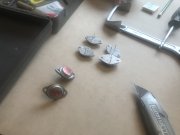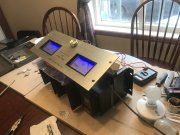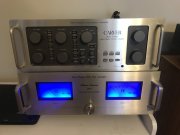- Joined
- Oct 15, 2014
- Messages
- 3,419
- Tagline
- ---not quite right
Figured I’d put this in a new bread instead of the DCP/WO light board one.
If you haven’t read the other thread, this amp is stock other than main caps and some repairs over the years. I installed a DCP board and a WO light board recently with no problems. I hooked it to a PL4000 pre amp which decided to randomly go full blast and toasted the 400.
This is really my first dive into a repair like this so I’m sure there will be lots of questions! Here’s where I’m at...
The left channel seems OK with my multimeter and has had its outputs replaced at some time with NEC2SD555’s and looks like the drivers have been changed also with one RCA 66546 and the other is Motorola MJ15015
The right channel has PL909 outputs which also look not original and has RCA 410 drivers. This channel has shorts.
So far I’ve desoldered the emitter resistors on the bad channel and found two shorted outputs. One on each rail. I brought her up on the DBT and she failed, only on for a second but the meters swung full sweep. I then realized I had a brain fart and that those outputs were probably shorted to base as well, which they were... I desoldered them from base buss bar which then showed no shorts on the multimeter. I then powered her up on a DBT again and she came to life and the bulb dimmed normally. I hope I didn’t toast anything worse than she was...
I have outputs on the way with a package from grapplesaw which should arrive this week. Question is, what’s next? How can I test for other issues such as the driver board or any other collateral damage?
If you haven’t read the other thread, this amp is stock other than main caps and some repairs over the years. I installed a DCP board and a WO light board recently with no problems. I hooked it to a PL4000 pre amp which decided to randomly go full blast and toasted the 400.
This is really my first dive into a repair like this so I’m sure there will be lots of questions! Here’s where I’m at...
The left channel seems OK with my multimeter and has had its outputs replaced at some time with NEC2SD555’s and looks like the drivers have been changed also with one RCA 66546 and the other is Motorola MJ15015
The right channel has PL909 outputs which also look not original and has RCA 410 drivers. This channel has shorts.
So far I’ve desoldered the emitter resistors on the bad channel and found two shorted outputs. One on each rail. I brought her up on the DBT and she failed, only on for a second but the meters swung full sweep. I then realized I had a brain fart and that those outputs were probably shorted to base as well, which they were... I desoldered them from base buss bar which then showed no shorts on the multimeter. I then powered her up on a DBT again and she came to life and the bulb dimmed normally. I hope I didn’t toast anything worse than she was...
I have outputs on the way with a package from grapplesaw which should arrive this week. Question is, what’s next? How can I test for other issues such as the driver board or any other collateral damage?
Attachments
-
2.8 MB Views: 23
-
2.7 MB Views: 22
-
2.6 MB Views: 23
-
2.9 MB Views: 23


